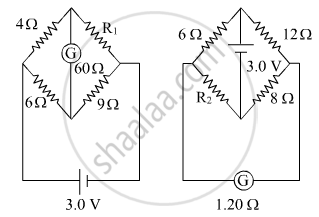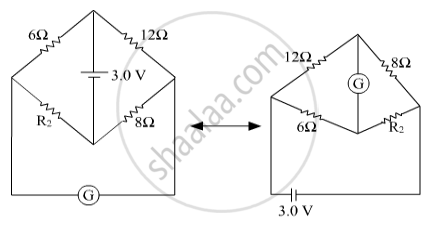Advertisements
Advertisements
प्रश्न
Figure shows two circuits each having a galvanometer and a battery of 3V.
When the galvanometers in each arrangement do not show any deflection, obtain the ratio R1/R2.

उत्तर

For balanced wheat stone bridge, there will be no deflection in the galvanometer.
`4/R_1 = 6/9 => R_1 =(4 xx 9)/6 = 6Ω`

For the equivalent circuit, when the wheat stone bridge is balanced, there will be no deflection in the galvanometer.
`therefore 12/8 = 6/R_2 => R_2 \ ( 6xx 8)/12 = 4 Ω`
`therefore R_1/R_2 = 6/4 = 3/2`
संबंधित प्रश्न
Show that the current flowing through a moving coil galvanometer is directly proportional to the angle of deflection of coil.
A moving coil galvanometer has a resistance of 25Ω and gives a full scale deflection for a current of 10mA. How will you convert it into a voltmeter having range 0 - 100 V?
A galvanometer has a resistance of 16Ω. It shows full scale deflection, when a current of 20 mA is passed through it. The only shunt resistance available is 0.06 which is not appropriate to convert a galvanometer into an ammeter. How much resistance should be connected in series with the coil of galvanometer, so that the range of ammeter is 8 A?
Define current sensitivity of a galvanometer.
Draw a labelled diagram of a moving coil galvanometer and explain its working. What is the function of radial magnetic field inside the coil?
A moving coil galvanometer has a coil of resistance 59 Ω. It shows a full-scale deflection for a current of 50 mA. How will you convert it to an ammeter having a range of 0 to 3A?
The current sensitivity of a galvanometer is defined as ______.
When a galvanometer is shunted with a 4 Ω resistance, the deflection is reduced to one-fifth. If the galvanometer is further shunted with a 2 Ω wire. The further reduction (find the ratio of decrease in current to the previous current) in the deflection will be (the main current remains the same)
Explain in brief the basic construction of a moving-coil table galvanometer whit a neat labelled diagram.
